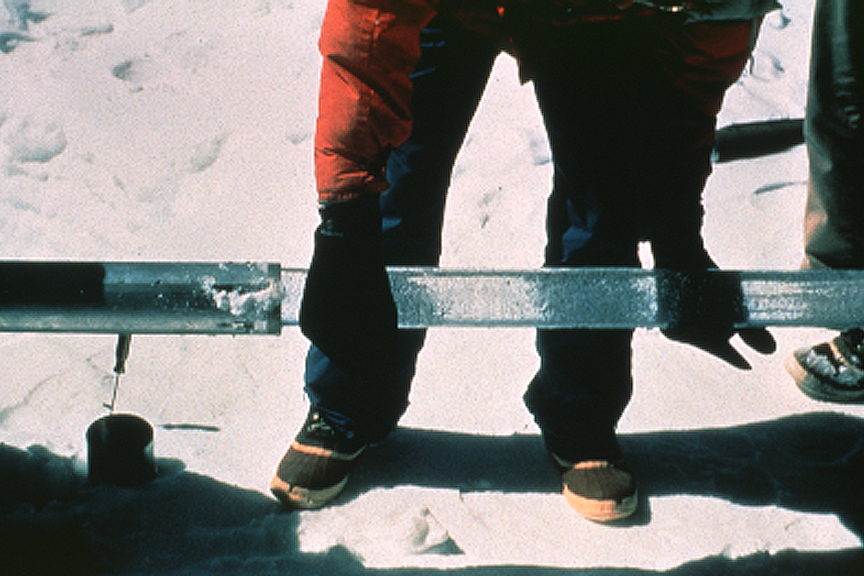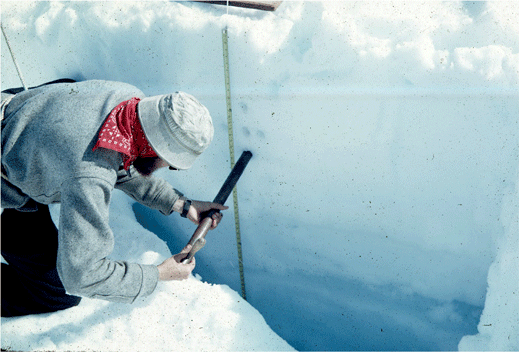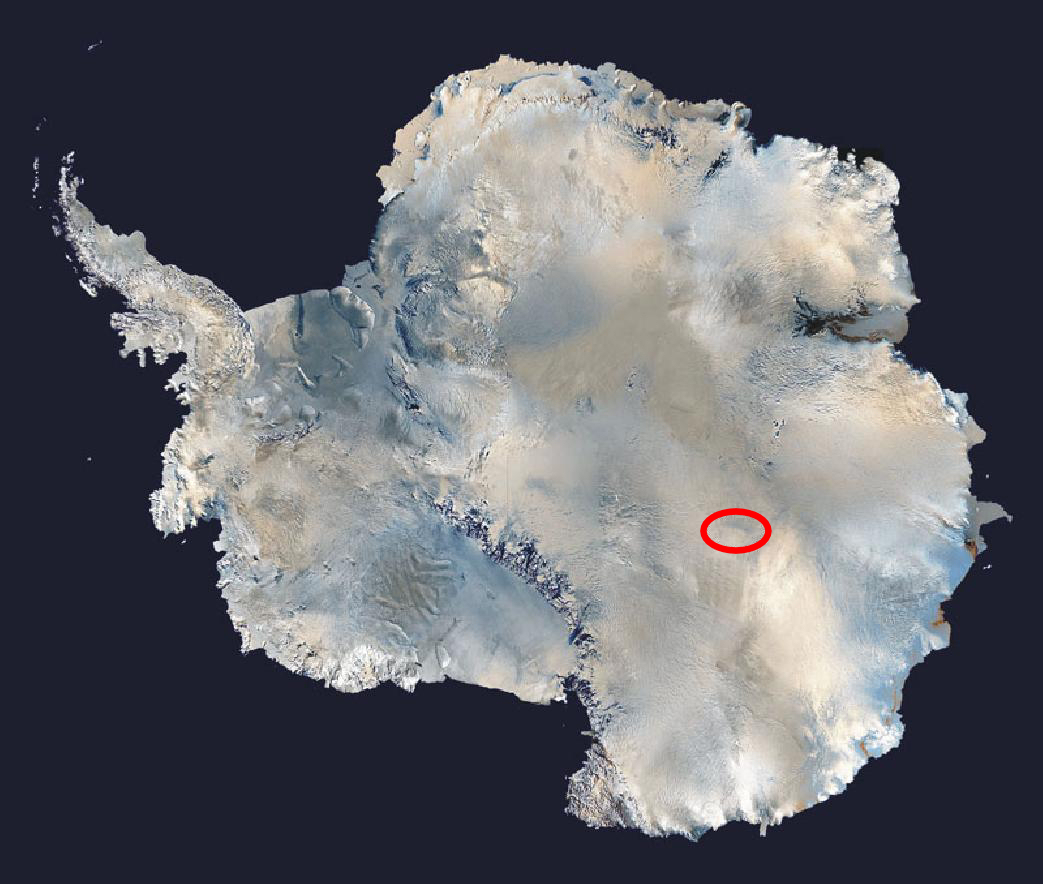|
European Project For Ice Coring In Antarctica
The European Project for Ice Coring in Antarctica (EPICA) is a multinational European project for deep ice core drilling in Antarctica. Its main objective is to obtain full documentation of the climatic and atmospheric record archived in Antarctic ice by drilling and analyzing two ice cores and comparing these with their Greenland counterparts ( GRIP and GISP). Evaluation of these records will provide information about the natural climate variability and mechanisms of rapid climatic changes during the last glacial epoch. The European Science Foundation EPICA Programme (1996–2005) provides co-ordination for EPICA drilling activities at Dome Concordia and Kohnen Station, which are supported by the European Commission and by national contributions from Belgium, Denmark, France, Germany, Italy, the Netherlands, Norway, Sweden, Switzerland and the United Kingdom. Deep drilling took place at two sites in Antarctica: Concordia Station at Dome C and Kohnen Station. In 2008 the pro ... [...More Info...] [...Related Items...] OR: [Wikipedia] [Google] [Baidu] |
Ice Core
An ice core is a core sample that is typically removed from an ice sheet or a high mountain glacier. Since the ice forms from the incremental buildup of annual layers of snow, lower layers are older than upper ones, and an ice core contains ice formed over a range of years. Cores are drilled with hand augers (for shallow holes) or powered drills; they can reach depths of over two miles (3.2 km), and contain ice up to 800,000 years old. The physical properties of the ice and of material trapped in it can be used to reconstruct the climate over the age range of the core. The proportions of different oxygen and hydrogen isotopes provide information about ancient temperatures, and the air trapped in tiny bubbles can be analysed to determine the level of atmospheric gases such as carbon dioxide. Since heat flow in a large ice sheet is very slow, the borehole temperature is another indicator of temperature in the past. These data can be combined to find the climate model ... [...More Info...] [...Related Items...] OR: [Wikipedia] [Google] [Baidu] |
EPICA Delta D Plot
{{disambiguation ...
Epica or EPICA may refer to: * Epica (band), a Dutch symphonic metal band * ''Epica'' (Kamelot album), 2003 * ''Epica'' (Audiomachine album), 2012 * The European Project for Ice Coring in Antarctica (EPICA) * The Epica Awards (International Advertising Awards) * Daewoo Tosca, also known as Chevrolet Epica or Holden Epica * Daewoo Magnus, also known as Chevrolet Epica * ''Banksia epica'', a South Australian native bush See also *Epic (other) Epic commonly refers to: * Epic poetry, a long narrative poem celebrating heroic deeds and events significant to a culture or nation * Epic film, a genre of film with heroic elements Epic or EPIC may also refer to: Arts, entertainment, and med ... [...More Info...] [...Related Items...] OR: [Wikipedia] [Google] [Baidu] |
Outposts Of Antarctica
''Outposts: Journeys to the surviving relics of the British Empire'' is a book by Simon Winchester. It details his travels to each of the remaining dependencies of the British Empire and was first published in 1985 in Britain by Hodder and Stoughton under the title ''Outposts'' and in the United States by Prentice Hall as ''The Sun Never Sets: Travels to the Remaining Outposts of the British Empire''. It was reprinted in 2003 with a new foreword written to address the changing political climate and attitudes in relation to the British Empire, most importantly concerning the handover of Hong Kong to China and, more generally, the rise of globalism. Publication history *''Outposts: Journeys to the Surviving Relics of the British Empire'' (1985), Hodder & Stoughton *''The Sun Never Sets: Travels to the Remaining Outposts of the British Empire'' (1985), Prentice Hall *''Outposts: Journeys to the Surviving Relics of the British Empire'' revised ed. (2003), Penguin Penguins (ord ... [...More Info...] [...Related Items...] OR: [Wikipedia] [Google] [Baidu] |
Ice Core
An ice core is a core sample that is typically removed from an ice sheet or a high mountain glacier. Since the ice forms from the incremental buildup of annual layers of snow, lower layers are older than upper ones, and an ice core contains ice formed over a range of years. Cores are drilled with hand augers (for shallow holes) or powered drills; they can reach depths of over two miles (3.2 km), and contain ice up to 800,000 years old. The physical properties of the ice and of material trapped in it can be used to reconstruct the climate over the age range of the core. The proportions of different oxygen and hydrogen isotopes provide information about ancient temperatures, and the air trapped in tiny bubbles can be analysed to determine the level of atmospheric gases such as carbon dioxide. Since heat flow in a large ice sheet is very slow, the borehole temperature is another indicator of temperature in the past. These data can be combined to find the climate model ... [...More Info...] [...Related Items...] OR: [Wikipedia] [Google] [Baidu] |
Jean Robert Petit
Jean-Robert Petit studied chemistry and physics at the University of Grenoble and received a PhD in 1984 in paleoclimatology on the study of the aeolian dust record from Antarctic ice cores. Academic works In 1999 he was the lead author of a study published in Nature, "Climate and atmospheric history of the past 420,000 years from the Vostok ice core, Antarctica." The paper presented the first long climate record from the ice. It provided a continuous record of temperature and atmospheric composition. The data extracted from this ice core had implications throughout the fields of glaciology and paleoclimatology. One of the concluding remarks was that present day levels of carbon dioxide and methane seem to have been unprecedented during the past 420,000 years. The paper has been cited 3953 times to date. Ice cores He was also a member of the EPICA project, a European team that drilled an ice core at Dome C that provided, in 2004, a 740,000-year climate record. See also * ... [...More Info...] [...Related Items...] OR: [Wikipedia] [Google] [Baidu] |
Dome F
Dome Fuji (ドームふじ ''Dōmu Fuji''), also called Dome F or Valkyrie Dome, is an Antarctic base located in the eastern part of Queen Maud Land at . With an altitude of above sea level, it is the second-highest summit or ''ice dome'' of the East Antarctic Ice Sheet and represents an ice divide. Dome F is the site of Dome Fuji Station, a research station operated by Japan. Discovery and naming Dome Fuji is an ice dome rising to about in the eastern part of Queen Maud Land. In 1963–1964, a Soviet Antarctic Expedition oversnow traverse crossed the northern part of the dome at an elevation of over . Environment Owing to its location on the Antarctic Plateau and the high elevation, Dome Fuji is one of the coldest places on Earth. Temperatures rarely rise above in summer and can drop to in winter. The annual average air temperature is . The climate is that of a cold desert, with very dry conditions and an annual precipitation of about of water equivalent, which falls en ... [...More Info...] [...Related Items...] OR: [Wikipedia] [Google] [Baidu] |
Brunhes–Matuyama Reversal
The Brunhes–Matuyama reversal, named after Bernard Brunhes and Motonori Matuyama, was a geologic event, approximately 781,000 years ago, when the Earth's magnetic field last underwent reversal. Estimations vary as to the abruptness of the reversal. A 2004 paper estimated that it took over several thousand years; a 2010 paper estimated that it occurred more quickly, perhaps within a human lifetime; a 2019 paper estimated that the reversal lasted 22,000 years. The apparent duration at any particular location can vary by an order of magnitude, depending on geomagnetic latitude and local effects of non-dipole components of the Earth's field during the transition. The Brunhes–Matuyama reversal is a marker for the Global Boundary Stratotype Section and Point (GSSP) defining the base of the Chibanian Stage and Middle Pleistocene Subseries at the Chiba section, Japan, which was officially ratified in 2020 by the International Union of Geological Sciences. It is useful in dating ocea ... [...More Info...] [...Related Items...] OR: [Wikipedia] [Google] [Baidu] |
Proxy (climate)
In the study of past climates ("paleoclimatology"), climate proxies are preserved physical characteristics of the past that stand in for direct meteorological measurements and enable scientists to reconstruct the climatic conditions over a longer fraction of the Earth's history. Reliable global records of climate only began in the 1880s, and proxies provide the only means for scientists to determine climatic patterns before record-keeping began. A large number of climate proxies have been studied from a variety of geologic contexts. Examples of proxies include stable isotope measurements from ice cores, growth rates in tree rings, species composition of sub-fossil pollen in lake sediment or foraminifera in ocean sediments, temperature profiles of boreholes, and stable isotopes and mineralogy of corals and carbonate speleothems. In each case, the proxy indicator has been influenced by a particular seasonal climate parameter (e.g., summer temperature or monsoon intensity) at the t ... [...More Info...] [...Related Items...] OR: [Wikipedia] [Google] [Baidu] |
Vostok Station
Vostok Station (russian: :ru:Восток (антарктическая станция), ста́нция Восто́к, translit=stántsiya Vostók, , meaning "Station East") is a Russian Research stations in Antarctica, research station in inland Princess Elizabeth Land, Antarctica. Founded by the Soviet Union in 1957, the station lies at the southern Pole of Cold, with the List of weather records#Lowest temperatures recorded, lowest reliably measured natural temperature on Earth of .Global Measured Extremes of Temperature and Precipitation. National Climatic Data Center. Retrieved on 21 June 2007. Research includes ice core drilling and Magnetometer, magnetometry. Vostok (Russian for ''"east"'') was named after ''Vostok (sloop-of-war), Vostok'', the lead ship of the First Rus ... [...More Info...] [...Related Items...] OR: [Wikipedia] [Google] [Baidu] |
Descartes Prize
The Descartes Prize was an annual award in science given by the European Union, named in honour of the French mathematician and philosopher, René Descartes. The prizes recognized Outstanding Scientific and Technological Achievements Resulting from European Collaborative Research. The research prize was first awarded in 2000 and was discontinued in 2007. The research prize was awarded to teams of researchers who had "achieved outstanding scientific or technological results through collaborative research in any field of science, including the economic, social science and humanities." Nominations were submitted by the research teams themselves or by suitable national bodies. A science communication prize was also started in 2004 as part of the Descartes Prize but in 2007 was separated to the Science Communication Prize. Proposals (also referred to as submissions) received were judged and a shortlist of nominees were announced, from which five Laureates (finalists) and five Winne ... [...More Info...] [...Related Items...] OR: [Wikipedia] [Google] [Baidu] |
Antarctica
Antarctica () is Earth's southernmost and least-populated continent. Situated almost entirely south of the Antarctic Circle and surrounded by the Southern Ocean, it contains the geographic South Pole. Antarctica is the fifth-largest continent, being about 40% larger than Europe, and has an area of . Most of Antarctica is covered by the Antarctic ice sheet, with an average thickness of . Antarctica is, on average, the coldest, driest, and windiest of the continents, and it has the highest average elevation. It is mainly a polar desert, with annual precipitation of over along the coast and far less inland. About 70% of the world's freshwater reserves are frozen in Antarctica, which, if melted, would raise global sea levels by almost . Antarctica holds the record for the lowest measured temperature on Earth, . The coastal regions can reach temperatures over in summer. Native species of animals include mites, nematodes, penguins, seals and tardigrades. Where vegetation o ... [...More Info...] [...Related Items...] OR: [Wikipedia] [Google] [Baidu] |
Kohnen Station
Kohnen-Station is a German summer-only polar research station in the Antarctic, able to accommodate up to 28 people. It is named after the geophysicist Heinz Kohnen (1938–1997), who was for a long time the head of logistics at the Alfred Wegener Institute. The station opened on January 11, 2001, in Dronning Maud Land. The station is located at 75°00'S, 00°04'E, and 2892 m above sea level. It is located 757 km southeast of Neumayer-Station III, which lies on the Ekstrom Ice Shelf and provides logistics and administration for Kohnen-Station. Like the United Kingdom's Halley V station, the base is built on steel legs allowing the station to be jacked up as the height of the snow surface increases. The station contains a radio room, a mess room, a kitchen, bathrooms, two bedrooms, a snow melter, a store, a workshop, and a power plant (100 kW). It is supplied by a convoy of 6 towing vehicles, which carry up to 20 tons each, and 17 sledges. The base is resupplied ... [...More Info...] [...Related Items...] OR: [Wikipedia] [Google] [Baidu] |



